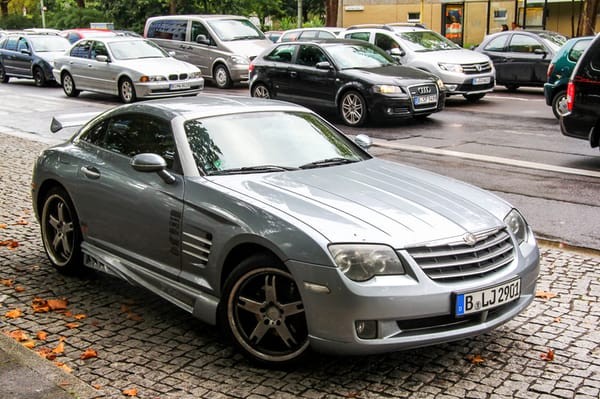The Chrysler Crossfire, produced between 2004 and 2008, remains a distinctive figure in automotive history. This two-seater sports car uniquely combined American design sensibilities with robust German engineering, primarily thanks to a significant contribution from Mercedes-Benz. For those seeking a stylish and engaging ride that stands out from the crowd, the Crossfire continues to be an intriguing option on the used car market.
The DaimlerChrysler Alliance: A Fusion of Automotive Worlds
The story of the Chrysler Crossfire is intrinsically linked to the DaimlerChrysler merger, a corporate alliance that spanned from 1998 to 2007. This ambitious partnership aimed to unite the strengths of American and German automotive giants. The Crossfire emerged as a direct beneficiary of this collaboration, effectively becoming a Chrysler-badged variant of the Mercedes-Benz SLK roadster. This meant it inherited a substantial portion of its engineering DNA, platform, and components directly from Mercedes-Benz.
The very name “Crossfire” is said to reflect this dual heritage. It alludes to the striking character lines sculpted along the vehicle’s flanks, converging dramatically just below the door handles. Beyond this visual cue, “Crossfire” can also be interpreted as a symbolic representation of the intersection and blending of design philosophies and engineering expertise from Chrysler and Mercedes-Benz.
Exterior Elegance and Mercedes-Powered Performance
The Chrysler Crossfire’s exterior design was undeniably a major draw. Its sleek, low-slung silhouette, emphasized by pronounced wheel arches and sharply styled headlights, projected an aura of dynamism and purpose. The Roadster version, introduced in 2005, amplified the car’s sporty appeal by offering the exhilaration of open-top driving.
Beneath the Crossfire’s captivating exterior resided a powerful heart originating from Mercedes-Benz. The standard models were equipped with a Mercedes-sourced 3.2-liter V6 engine, delivering 215 horsepower. For enthusiasts craving even more performance, the SRT-6 variant boasted a supercharged version of the same V6, pushing output to an impressive 330 horsepower. This potent engine, coupled with the Crossfire’s rear-wheel-drive configuration, provided thrilling acceleration and a rewarding exhaust note, transforming every drive into an engaging experience, especially on winding roads. The Mercedes engine ensured a level of refinement and reliability that was a significant selling point for the Crossfire.
Mercedes-Inspired Interior and Features
Stepping inside the Chrysler Crossfire revealed further evidence of Mercedes-Benz influence. The interior prioritized high-quality materials and driver-centric ergonomics. The leather seats offered excellent support and comfort, while the cockpit layout ensured that all essential controls were easily accessible. The instrument gauges were clear, concise, and easy to read, and the availability of a premium sound system contributed to a more luxurious and immersive cabin environment. Many components, from switchgear to the infotainment system (in later models), were shared or heavily inspired by Mercedes-Benz designs of the era.
However, some automotive critics pointed out that the interior space could feel somewhat compact, especially for taller individuals. Additionally, the sloping rear roofline did compromise rear visibility to a degree.
Crossfire Trims and Model Variations
Throughout its production lifespan, the Chrysler Crossfire was available in several trim levels, catering to different preferences and performance expectations:
- Base: The entry-level Crossfire featured the 215-horsepower V6 engine, offered with a six-speed manual transmission or an optional automatic. It came well-equipped with a range of standard features expected in a sports car of its class.
- Limited: This trim level added further refinements, including heated leather seats, an electric sunroof, and an upgraded premium sound system, enhancing the comfort and luxury aspects of the Crossfire.
- SRT-6: Representing the pinnacle of Crossfire performance, the SRT-6 model featured the supercharged 330-horsepower V6 engine, a sport-tuned suspension system, and enhanced braking components. It delivered a significantly more aggressive and dynamic driving experience aimed at performance enthusiasts. This variant truly showcased the potential of the Mercedes-Benz powertrain within the Chrysler chassis.
A Cult Classic in the Making
Despite its appealing blend of style and Mercedes-Benz engineering, the Chrysler Crossfire’s sales figures remained modest. Its positioning in a niche market segment, combined with a premium price point, limited its broader market appeal. The global financial crisis of 2008 further impacted sales, ultimately leading Chrysler to discontinue the Crossfire after the 2008 model year.
The Chrysler Crossfire in Today’s Used Car Market
Today, the Chrysler Crossfire enjoys a strong following among car enthusiasts. Its unique combination of striking design and German-engineered components continues to attract those seeking a distinctive and capable two-seater sports car at a potentially attractive price point in the used market. The “Crossfire Mercedes” connection remains a key selling point for many buyers.
For those considering purchasing a used Chrysler Crossfire, it’s important to be aware that maintenance costs, particularly for models with Mercedes-derived components, can be higher compared to some mainstream sports cars. Therefore, seeking out a well-maintained example with a comprehensive service history is crucial. However, for those willing to invest in its upkeep, the Chrysler Crossfire offers a unique ownership experience.
In conclusion, the Chrysler Crossfire represents a fascinating chapter in automotive collaboration. It provided a compelling and stylish alternative in the sports car segment, delivering a taste of German engineering wrapped in American design flair. While its production run was relatively brief, the Crossfire’s distinctive character and engaging driving dynamics ensure its continued appeal and status as a modern classic, particularly for those who appreciate the unique blend of “crossfire mercedes” in its DNA.
